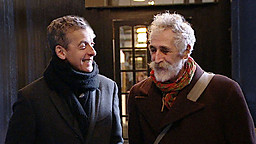FEBRUARY 1st: screening
Actor and director Peter Capaldi meets artist and playwright John Byrne at Glasgow School of Art, where both were once students.
They talk about the artistic paths they have each followed. A conversation that takes in the work of John's 1960s alter-ego Patrick and his acclaimed dramas The Slab Boys trilogy and Tutti Frutti, as well as Peter's journey from playing the fresh-faced youth of Local Hero in 1983 to the foul-mouthed Malcolm Tucker in The Thick of It.
Followed by an Artworks Scotland feature on Steven Campbell, the greatest of the new Glasgow painters of the late 20th century.
February 8th audio podcast and discussion
Scenes from a marriage: art and theory
A panel discussion from Frieze Art fair.
Since the 1980s, when buzzwords like ‘semiotics’ were prevalent in the art world, theory has played an important role in the interpretation, and making, of art. Yet, after all these years, has contemporary art really influenced the way philosophers think? And is theory still relevant to today’s artists?
- Simon Critchley (Chair & Professor of Philosophy at The New School for Social Research, New York)
- Robert Storr (Artist, Critic, Curator and Dean of Yale School of Art)
- Barbara Bloom (Artist)
- Chair: Jörg Heiser (Co-editor, frieze)
Available to download at
Listening to this in advance would be helpful, enabling re-listening together followed by discussion on the day.
February 15th screening
Helen ChadwickUntil her unexpected death in 1996, Helen Chadwick was amongst the most sparkling, provocative and distinctive of artists. Her sensual and rigorously intellectual works explore desire, sexuality and the body.
Produced alongside a major retrospective exhibition, organised by London's Barbican Art Gallery, this film provides a rare opportunity to to reflect on her art. Important installations are featured, such as Ego Geometria Sum, which uses photographs of her own naked body, and the Baroque fantasy The Oval Court, as well as more controversial pieces, including Cacao, a fountain of hot bubbling chocolate, and the Piss Flowers, sculptures made by casting the holes left after urinating in snow.
Louise Hopkins
short film from the Fruitmarket Gallery show
“Freedom of Information drawings paintings 1996—2005”
Hopkins rarely makes work on blank surfaces, choosing rather to work on supports which already contain information, turning that information into a painting by repainting and hence transforming it. She re-works something familiar and legible, making deliberate adjustments to the printed matter, forcing the viewer to look closely and re-consider the existing marks alongside the additions.
short film from the Fruitmarket Gallery show
“Freedom of Information drawings paintings 1996—2005”
Hopkins rarely makes work on blank surfaces, choosing rather to work on supports which already contain information, turning that information into a painting by repainting and hence transforming it. She re-works something familiar and legible, making deliberate adjustments to the printed matter, forcing the viewer to look closely and re-consider the existing marks alongside the additions.
February 22nd screening
Claire Doherty'The Event of Situation: Contemporary Art, Place and Time'
A talk given at Glasgow School of Art Friday Event, Feb 2009
In 2007, the term 'situation-specific' emerged in critical appraisals of international scattered-site commissions such as Sculpture Project Münster, Germany, and in consideration of works such as Pawel Althamer's Real Time Movie, a performative intervention dispersed across different localities and times. Drawing on trans-disciplinary notions of place, time and locality, Claire Doherty will consider how our understanding of situation has developed from the Situationist intervention to dispersed events and interventions in public space, to offer a new interpretation of situation-specificity and the artwork as event.
Claire Doherty is a curator and writer and Director of Situations, a research and commissioning programme at the University of the West of England, Bristol. Over the past 13 years, she has investigated new forms of curatorial practice beyond conventional exhibition models at institutions such as Ikon Gallery, Birmingham, Spike Island, Bristol and FACT, Liverpool. Situations has expanded since its inception in 2003 to include a range of publishing projects, international lectures, events, and off-site commissions by artists including Phil Collins, Nathan Coley, Susan Hiller, Roman Ondak, Joao Penalva and Ivan & Heather Morison.
A wide range of online videos can be browsed at http://www.gsa.ac.uk/life/gsa-events/archive/


